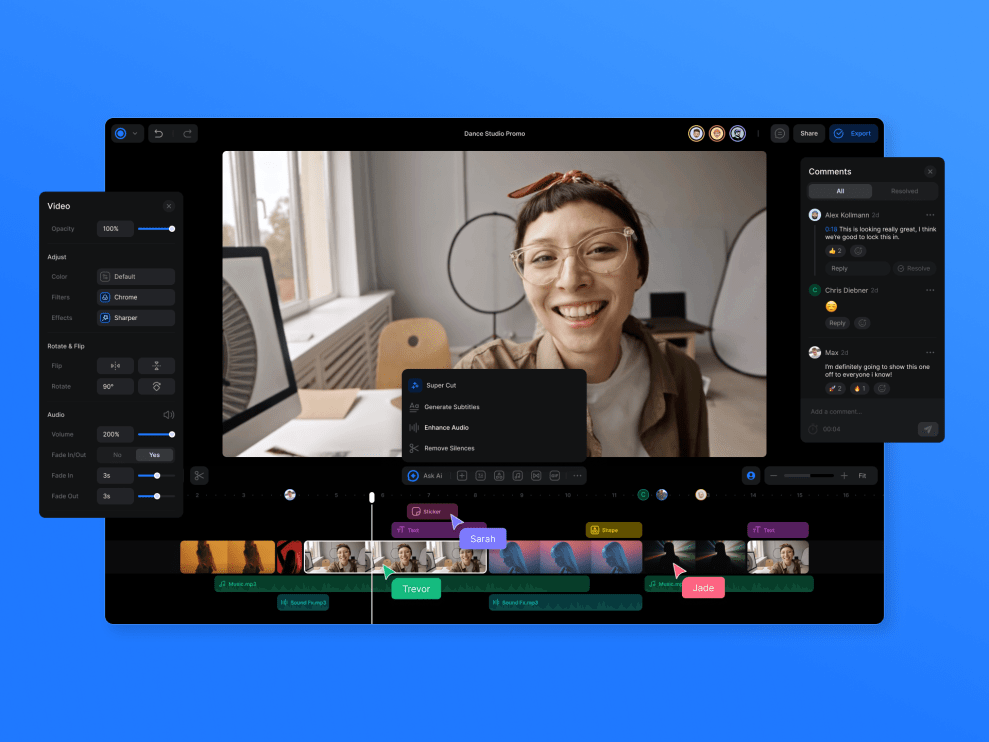The creator of an AI-powered cloud-based collaborative video editor called Ozone has secured $7.1 million in early money and is putting their product into open beta. The former Y Combinator employee wants to provide video producers with AI support so they can finish time-consuming editing jobs quickly—instead of hours. Ozone intends to provide content producers with tools to make entertaining films more rapidly and effectively, not to replace human creativity with AI.
Max von Wolff founded Ozone in 2021. It is an in-house AI assistant that suggests user activities to perform when editing videos. The program offers real-time, Figma-like collaboration, limitless cloud storage, and video editing capabilities. With AI’s assistance, you may execute various tasks, like adding music, adding subtitles and animations, removing silences, color correcting, and more.
“I studied computer science at MIT,” von Wolff said in an interview with TechCrunch. “My desire to pursue creativity grew. This cloud computing course I was taking sparked my interest in developing cloud-based creativity software that encourages people to be at their most creative. I chose to drop out of MIT as a sophomore and attend Y Combinator despite being an international student. That’s how we got things going. We’re creating the first AI-driven collaborative video editor in your web browser.
Engineers, designers, and product managers comprise Ozone’s nine-person team from Adobe, Frame.io, InVision, and Disney. Customers can submit their videos to Ozone and instantly apply various AI functions to complete tasks that would otherwise require a lot of manual labor. For example, you may easily remove pauses and times when you say “um” or “uh” from a video you publish.
At first, Ozone focuses on content marketers and artists who produce short-form videos for applications such as YouTube, Instagram, and TikTok. With time, Ozone intends to expand its editing skills, focusing on producers of longer material, such as movies and documentaries.
Van Wolff claims that although Ozone has many professional-grade editing tools offered by Adobe Premiere Pro and Final Cut Pro, these programs are complex and do not facilitate teamwork.
Van Wolff remarked, “If you look at the landscape, there is Adobe; they’ve been in the game for many decades, but their tools are very difficult to use.” They’re all offline and jumbled as well. In them, you cannot work together. Many individuals are irritated with the current answer. And we genuinely want to provide them with a tool that is just as powerful, if not more so, but with a degree of ease of use that I believe the industry has never seen before.
The startup intends to use a freemium business model when Ozone is live. While businesses will pay enterprise pricing that has not yet been determined, individual Pro users can access the program for just $29 monthly.
Regarding the money, the business intends to utilize it to expand the platform’s capabilities and add new features, such as more AI functionality, that will probably emerge in the upcoming months.
Along with the creators of Dropbox, Tinder, and Lightricks, the round featured financing from Y Combinator, NEA, General Catalyst, LGVP, Bluewatch Ventures, Polymath Capital Partners, Pioneer Fund, SOMA Capital, and Olive Tree Capital.
Van Wolff remarked, “I believe that we’re just getting started serving a small part of the market here in terms of the next ten years for Ozone.” “In order to cover additional sectors and use cases within our platform, we want to offer more functionalities. Regarding artificial intelligence, I firmly believe that in the next year or two, we will make further strides that will enable people to produce precisely what they envision, more quickly, and with a high level of quality.

